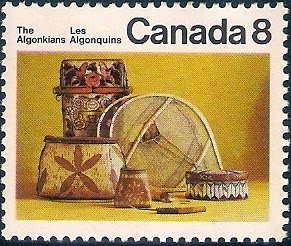 |
| 2004: Arts and Crafts |
The only jewellery stamp I could think in my collection was this Navajo silver and turquoise necklace and I imagine it is a stamp that might be owned by many others. A 2 cent increase of postage in 2006 meant the US Post, in anticipation of demand, reprinted this 2004 2c stamp as a 'make up' stamp and then, another 2 cent increase occurred the following year in 2007 so demand remained. For all you would ever need, or perhaps want to know, here is a whole page on it and its variations from
Philatelic Mineralogy.
The fact that this is Navajo jewellery got me thinking that perhaps I might have some cultural artefacts from North America and thanks to a series of Canadian stamps, which started in 1972 and continued until 1976 about various indigenous tribes I did. The series started with the theme of
the 'Indians of the Plains'. By coincidence I saw a exhibition in the Manchester Museum last year called Warriors of the Plains where I lusted after the soft moccasins and boots displayed. Only one piece of footwear makes an appearance on this stamp of artefacts photographed by Ray Webber of objects from the Royal Ontario Museum and the National Museum of Man. L to R a club, feather headdress, woman's saddle, beaded saddle bag, a moccasin, decorated bison skull, a parflèche bag and a calumet or pipe.
The stamp series were issued se-tenant and another continuing theme was the Thunderbird a symbol of divinity and the spirit guides of sun and thunder. We travel further north with these and a harsher life with the 'Indians of the Subarctic' and portrayed is an Ojibwa Thunderbird with a decorative strip from the coat of a Naskapi. The stamp on the right is of the Kutchin Tribe (painted by Lewis Parker) well wrapped up against the cold.
L to R drum, scorched caribou scapula bone, a mitishi (beaded charm), woman's hat, decorated bear skull, toy bear and a model canoe. The canoe is Chipewyan and all the other objects are Montagnais-Naskapi.
Next is 'The Algonquins' a family of languages spoken over a wide area of Canada
and the stamp shows the Miemac painted by an unknown person as they fish and live by the water where in common with other Algonquins birch bark was used extensively for all sorts of objects such as canoes, wigwams and containers.
L to R Tête-de-Boule birchbark basket, Ojibwa wooden papoose carrier, a pair of snowshoes for a Montagnais child, a Malecite birch bark basket, a Montagnais birch bark box, Montagnais knife and a Micmac birch bark basket decorated with porcupine quill work.
An entry to Viridian Postcard's Sunday Stamps theme of Cultural Artifacts especially jewellery
here



















